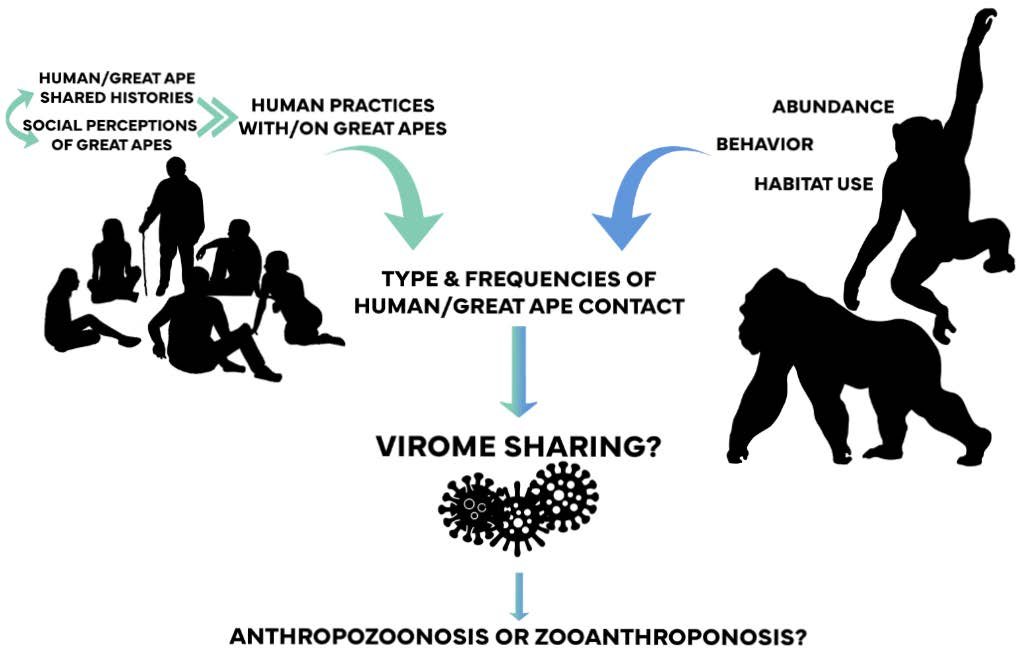A study conducted in Cameroon looked at enteric viruses in humans and some great ape species. These viruses share the same genomes. This "sharing" is thought to be a result of hunting, meat consumption and pillaging by great apes. The findings confirm the scale of pathogen transmission between humans and animals, which can represent a threat to human and animal health.
A recent study has revealed a high degree of convergence between the genomes of enteric eukaryotic viruses in humans and great apes in a Cameroonian forest. This research on "viromes" was conducted in collaboration with the Institut Pasteur, the CNRS, the Pasteur Center in Cameroon and Saint-Louis Hospital. Field observations in Cameroon were compared to the situation at a European zoo, where scientists Victor Narat from the CNRS and Tamara Giles-Vernick from the Institut Pasteur, together with her team, showed that there was less viral sharing.
Why are the genomes of enteric viruses in humans and great apes so similar?
The virome convergence observed in the Cameroonian forest is thought to be a result of farming spaces being shared with great apes, hunting, and pillaging of crops by great apes, unlike the situation in zoos where there is physical and environmental contact with zookeepers but hygiene measures such as handwashing are applied.
The study also compared the extent to which humans share their enteric virome with chimpanzees and revealed less frequent contact and a lower level of viral sharing. Enteric virome convergence between humans and gorillas in Cameroonian forests can be explained by physical and environmental contact.

Influences of human histories, perceptions, and practices and great ape ecology and behavior on eukaryotic intestinal virome sharing © M.Vernick / AdobeStock
Anthropology helps shed light on disease emergence
Pathogen transmission between humans and animals represents a threat to both human and animal health. This study incorporated metagenomic, historical, anthropological and ecological analyses and compared a site in the natural environment in Cameroon with a European zoo.
“Through a genuinely integrated One Health approach, we identified fields as a platform for viral sharing between people and great apes in the central African forest. This study shows how crucial it is for researchers examining zoonotic spillovers and spillbacks to bring together multiple disciplinary approaches, including the social sciences, to understand these complex events. Only by doing so can we anticipate these events – and prevent resulting epidemics,” explains Tamara Giles-Vernick, Head of the Institut Pasteur’s Anthropology and Ecology of Disease Emergence Unit.
Victor Narat conducted the research as part of his postdoctoral studies in the Medical Anthropology and Environment group, then headed by Tamara Giles-Vernick, within the Epidemiology of Emerging Diseases Unit led by Arnaud Fontanet.
The article will be included in the Nature Communications One Health collection.
Find out more on the CNRS website: Explorer la diversité des virus intestinaux des humains et des grands singes | INEE (cnrs.fr)
This study is part of the priority scientific area Emerging infectious diseases of the Institut Pasteur's strategic plan for 2019-2023.
Source :
Higher convergence of human-great ape enteric eukaryotic viromes in the central African forest than in a European zoo: a One Health analysis, Nature communications, June 21, 2023.
DOI : 10.1038/s41467-023-39455-9



